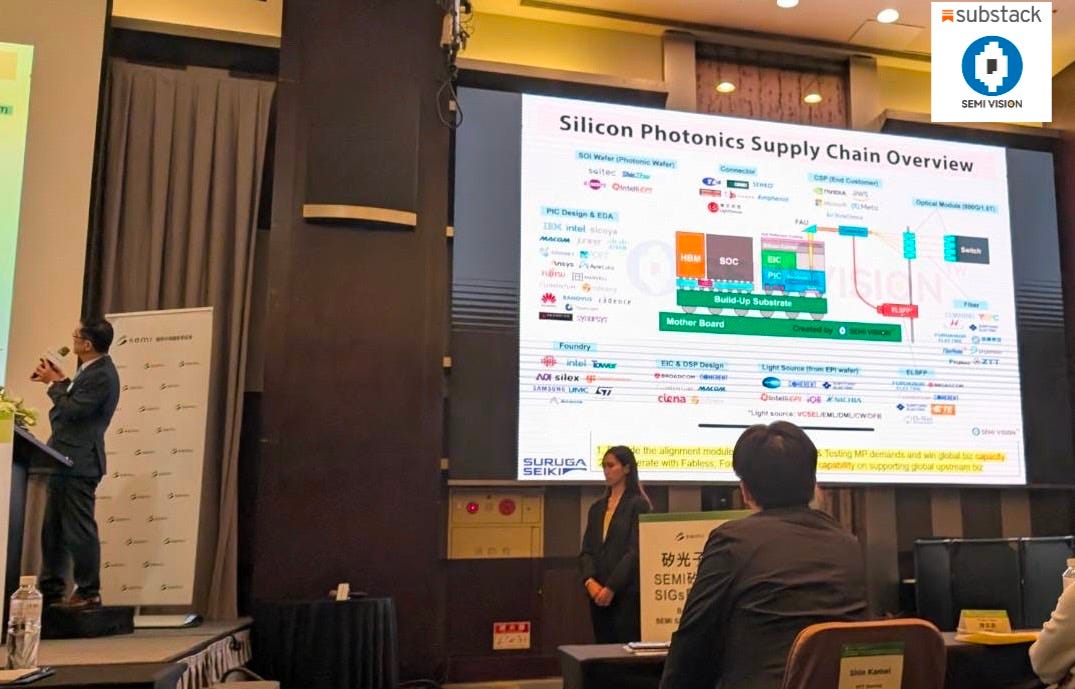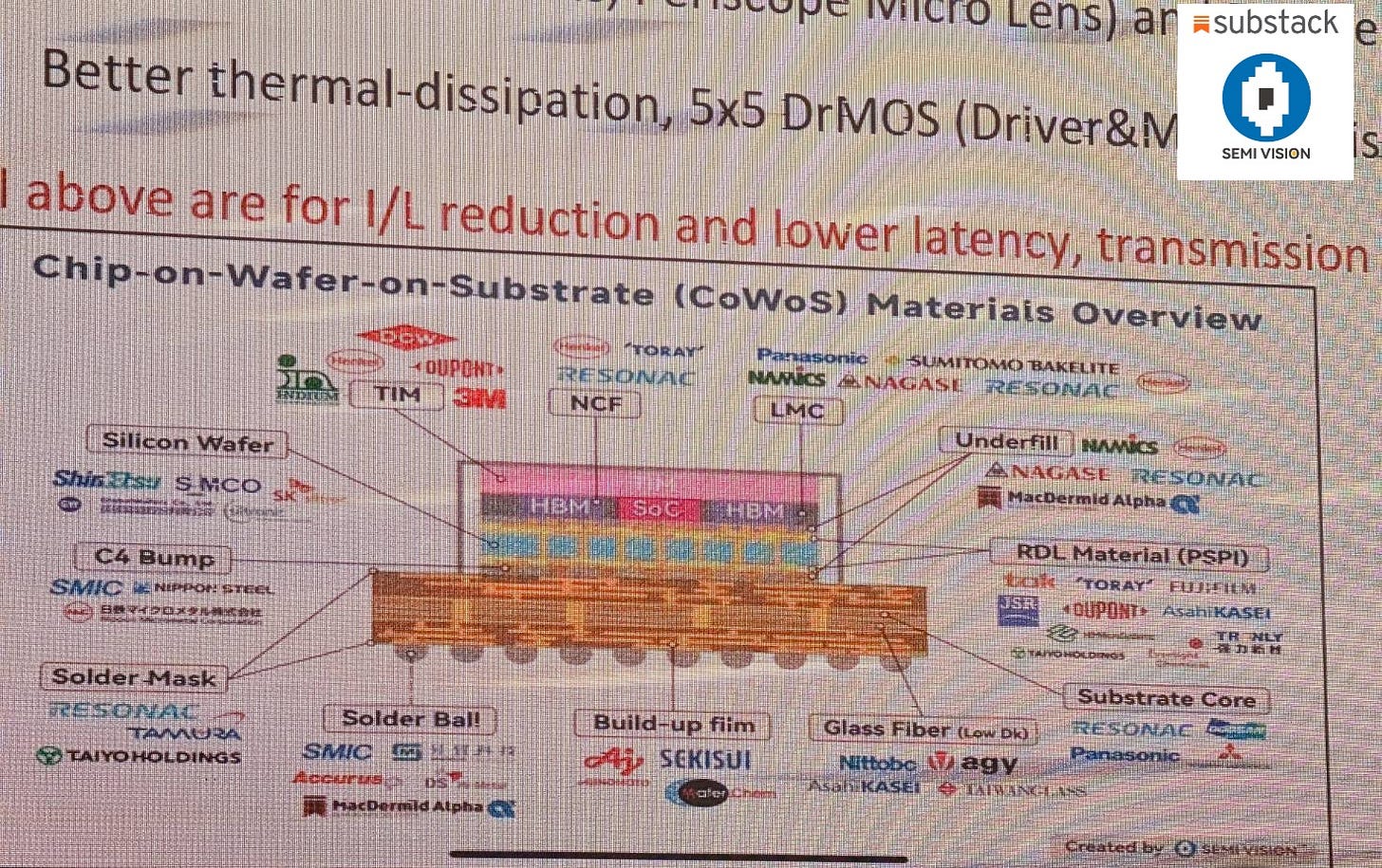Silicon Photonics Supply Chain – Opportunities and Challenges for Taiwan’s Supply Chain
Original Article by SemiVision Research
Silicon photonics is emerging as a major technological trend. To truly understand silicon photonics or optical engines, it is essential to grasp how foundries design photonic integrated circuit (PIC) process design kits (PDKs) and process flows. Taiwan holds a strategic advantage in this area, with a robust supply chain that includes TSMC, UMC, ITRI, the Hon Hai Research Institute, and leading research institutions dedicated to advancing the silicon photonics industry.
On April 11, 2025, SEMI organized a dedicated forum on silicon photonics to explore its future development. The SemiVision team also participated in this important event. We are pleased to share that one of the key coupler suppliers, SURUGA SEIKI, referenced our research on the silicon photonics supply chain as well as our CoWoS Material Overview during the forum.
SemiVision Research will conduct an in-depth analysis of this forum and share our insights with readers, focusing on the development roadmap and future outlook of Taiwan’s silicon photonics industry.
Silicon Photonics Technology and Industry Trends: A Perspective from Taiwan’s Supply Chain
The Role of Silicon Photonics in AI: Taiwan’s Rising Advantage and Challenges
As artificial intelligence (AI) continues to advance, so does the need for faster, more efficient computing technologies. One of the key innovations enabling this leap forward is silicon photonics—a technology that integrates light-based communication into silicon chips. This technology is poised to be a crucial enabler for AI, particularly in data centers, high-performance computing, and machine learning. Companies like Nvidia are already showing a highly optimistic outlook for silicon photonics, and with TSMC playing a pivotal role in its development, Taiwan’s silicon photonics industry is emerging as a global leader.
The Role of Silicon Photonics in AI
Silicon photonics involves the use of light to transmit data, which can dramatically increase data transmission speeds compared to traditional electrical interconnects. For AI applications, particularly in cloud computing and AI training, the need for faster and more energy-efficient data transfer is paramount. AI workloads demand immense computing power, and silicon photonics offers a solution by enabling ultra-fast data movement within servers and across data centers, all while reducing energy consumption.
In the world of AI, where real-time processing of massive amounts of data is necessary, silicon photonics provides a much-needed breakthrough. Optical data transmission can bypass the bottlenecks associated with electrical wiring, drastically increasing bandwidth and minimizing latency. This is especially important for AI training in deep learning models, where the transfer of data between processors must occur without delays that could slow down computations.
Nvidia’s Optimism for Silicon Photonics
Nvidia, a leader in AI hardware and software, has expressed a highly optimistic view regarding the potential of silicon photonics. Nvidia’s GPUs are at the core of AI processing, and the company has made significant investments in research and development surrounding silicon photonics. With the rise of AI, Nvidia sees silicon photonics as the future of data communication in high-performance computing.
As AI becomes increasingly integrated into more industries, Nvidia’s focus on silicon photonics highlights the growing importance of this technology. Their AI-specific hardware, coupled with photonic technologies, is expected to propel the company’s offerings into the next generation of high-performance computing. By embracing silicon photonics, Nvidia is ensuring that its data centers can support AI applications with the speed and efficiency that they demand.
TSMC’s Key Role in Silicon Photonics Development
TSMC, the world’s leading semiconductor foundry, plays a crucial role in the development and deployment of silicon photonics. As the go-to partner for companies like Nvidia, TSMC provides the advanced manufacturing processes that bring silicon photonics to life. TSMC’s expertise in chip design, coupled with its leading-edge fabrication capabilities, makes it uniquely positioned to support the growing demand for silicon photonic solutions in AI.
With the rise of AI, TSMC is investing heavily in R&D for silicon photonics to ensure its customers, including Nvidia, have the necessary technology for the next generation of AI processing. TSMC’s leadership in advanced semiconductor manufacturing, along with its increasing focus on optical interconnect technologies, makes it an essential player in the silicon photonics supply chain.
Taiwan’s Silicon Photonics Industry: Rising Advantages
Taiwan is emerging as a global hub for the silicon photonics supply chain. With its advanced semiconductor ecosystem, Taiwan has significant advantages in developing and scaling silicon photonics technology. Taiwan’s strength lies in its established expertise in semiconductor manufacturing, coupled with a strong emphasis on research and development. Companies like TSMC, MediaTek, and AU Optronics are leading the way in silicon photonics, contributing to the country’s rise as a powerhouse in photonics innovation.
Several factors give Taiwan a competitive edge:
1. Advanced Semiconductor Manufacturing: Taiwan is home to the world’s most advanced semiconductor foundries, led by TSMC. The country’s manufacturing prowess makes it uniquely capable of producing the high-precision silicon photonics components required for next-generation AI systems.
2. Strong R&D Ecosystem: Taiwan has a robust R&D environment, supported by both government and private sector investments in photonics and AI technologies. Universities and research institutes are also making strides in photonics innovation.
3. Established Supply Chain: Taiwan’s existing semiconductor ecosystem provides a well-established infrastructure for the silicon photonics supply chain, enabling companies to scale quickly and efficiently.
Challenges for Taiwan’s Silicon Photonics Industry
Despite Taiwan’s advantages, there are several challenges ahead:
1. Competition from Global Players: As countries like the U.S., China, and South Korea ramp up their investments in photonics, Taiwan must remain competitive by continuously innovating and improving its technology.
2. Talent Shortage: Silicon photonics requires a highly specialized workforce, and there is a need for more talent in both research and production. Taiwan will need to continue attracting and training experts in this field to maintain its competitive edge.
3. Supply Chain Complexity: Building a complete silicon photonics supply chain requires collaboration across many sectors, including materials science, photonic chip design, and packaging. Taiwan’s industry leaders must work together to ensure that all elements of the supply chain are in place and operate efficiently.
Building the Silicon Photonics Supply Chain
To establish a successful silicon photonics supply chain, Taiwan needs to focus on several key areas:
1. Collaboration Across Industries: Building a robust photonics ecosystem will require collaboration between semiconductor foundries, device makers, research institutions, and government agencies. This collective effort will accelerate innovation and create a comprehensive supply chain.
2. Investment in Materials and Design: Taiwan should prioritize investments in the development of advanced materials for photonic chips, along with designing photonic interconnects that can be integrated into existing semiconductor platforms.
3. Advanced Packaging and Integration: To fully realize the potential of silicon photonics, advanced packaging solutions that enable the integration of optical and electronic components will be essential. Taiwan has already established expertise in semiconductor packaging, which can be leveraged to develop integrated photonic-electronic systems.
4. Fostering Talent Development: Taiwan should invest in education and training programs to cultivate a workforce skilled in photonics, particularly in areas such as materials science, optical engineering, and semiconductor manufacturing.
Conclusion
Silicon photonics is set to play a crucial role in the future of AI, providing the speed and efficiency required to support advanced machine learning models and cloud-based AI services. Nvidia’s optimism about the technology, combined with TSMC’s expertise in semiconductor manufacturing, makes Taiwan a key player in the silicon photonics space. However, Taiwan’s industry must overcome challenges such as global competition and talent shortages to fully realize its potential. By investing in collaboration, materials innovation, and talent development, Taiwan can build a strong and competitive silicon photonics supply chain, cementing its position as a global leader in the AI-driven world of tomorrow.
For paid members , SemiVision Research will discuss the topics on
Evolution of Optical Communication in Data Centers and Bandwidth Demand
The Rise of Co-Packaged Optics (CPO)
Key Players’ CPO Developments
TSMC’s Integrated Optical Technologies (COUPE & CoWoS for Optics)
Taiwan’s Supply Chain Position in CPO Development
Development of Pluggable Optical Modules
Breakthroughs in Integrated Laser Source (ILS) Technology
Summary and Future Outlook(Nvidia Rubin chip)
If you would like to explore the silicon photonics roadmaps of TSMC and NVIDIA in greater depth, please refer to our previously published articles for more detailed analysis and insights.
How TSMC’s Silicon Photonics Could Impact NVIDIA’s Future
2025 GTC Review: The Silicon Photonics Era Has Arrived – Get Ready!
NVIDIA x TSMC: A Milestone in Silicon Photonics and Optical Integration
Nvidia GTC AI Conference Preview: GB300, CPO switches, and NVL288
TSMC and NVIDIA Pioneering the Future of AI with Silicon Photonics Technology
CPO Switch Technology Analysis
How to Distinguish Between CPO and OIO? What Is Their Fundamental Difference?







